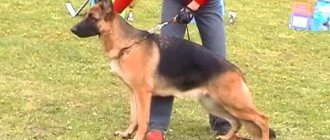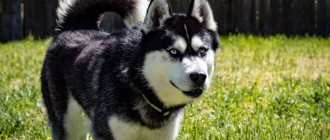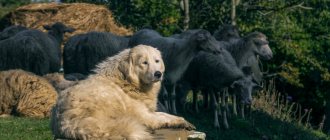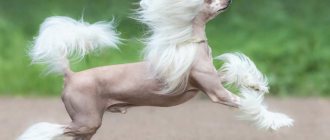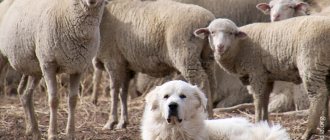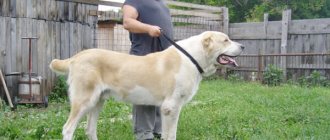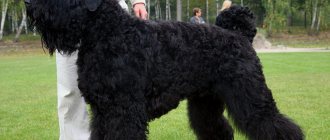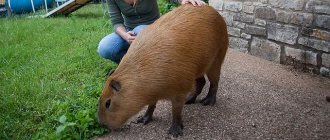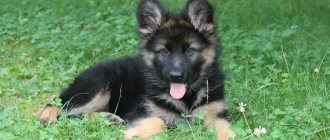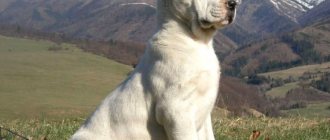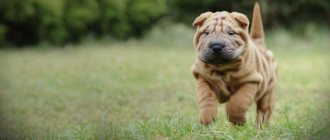The German Shepherd didn't always look the way it does now.
For more than a hundred years, the breed has been developing. In different time periods and in different regions of the world, certain requests for a service dog came to the fore, in accordance with which its appearance and qualities changed. You can read about modern types here.
Among our contemporaries there are many adherents of the old-type German Shepherd. What type is this? Let's take a closer look at this issue.
When experts talk about the old type, they mean an animal with strong bones that is taller, more sinewy and dry than specimens that meet the modern standard. It is believed that these were examples of the breed in Germany until the 40-50s of the 20th century.
Some adherents of this type of dog are confident that the Eastern Europeans - bred in the USSR, regarded by many experts as an offshoot of the German Shepherd and still not recognized by the International Canine Federation - are the closest match to this type of build.
Description
The German Shepherd is one of the most famous dogs in the world. This breed is respected for its rich history and great cultural influence in various world societies.
— Advertising —
According to the American Kennel Club, the animal ranks first on the list of “best police, security and military dogs.”
The first recognized specimens appeared in Germany in the late 1800s, the result of deliberate crossbreeding between farm dogs and herding dogs. Caring for this active and alert breed requires early socialization, obedience training, and attention to general health concerns.
Classification of breed by coat length
There are two types of German Shepherds based on their coat type: short-haired (smooth-haired) and long-haired.
Dogs of the first category have thick, hard fur, with an undercoat that fits tightly to the body. The hair on the tail, neck and hind legs is softer and longer than on other parts of the body.
Shepherd dogs of the second type differ from their short-haired counterparts in the length and structure of their fur. The dogs have long, soft, slightly wavy hair with a faint undercoat. The fur on the chest, neck and tail is especially long and fluffy. At the base of the ears and on the back of the paws, so-called fringes are formed from tufts of hair, giving the animals a playful and perky appearance.
Appearance
What does the animal look like? Breed standard.
The head is wedge-shaped, with a long face. Nose is black. The eyes are medium-sized, almond-shaped, set slightly obliquely, not protruding. The color is dark. The ears are straight, medium-sized, parallel, cone-shaped. Powerful mouth with a scissor bite. The upper incisors closely overlap the lower ones. The teeth are strong, light, there are 42 of them.
— Advertising —
The neck is strong, muscular, neat and relatively long. It is proportional in size to the head, without loose folds of skin. The back is straight and well developed. The chest is moderately wide and deep. Forelegs: shoulder blades long, sloping, placed flat. When viewed from all sides, the legs are straight. The hind legs are parallel, with muscular thighs. The tail should reach at least to the hock joint.
Males are usually larger than females. The normal weight of individuals is 22-40 kg, height is 55-65 cm.
The breed has a thick double coat of coat that protects from the elements. The outer coat is harsh, while the undercoat is fluffy, soft and dense. The head, inner ear and forehead, as well as the legs and paws are covered with short hairs. The neck comes with longer and thicker hairs.
Most common colors:
- Black.
- Black and red.
- Sobolinaya.
- Brown.
- Rare: gray color.
Black and zoned are special names for popular coat colors.
German Shepherd Old German Shepherd, German Shepherd - are they different breeds?
Origin of the Old German Shepherd
Breeding the German Shepherd in East Germany In the GDR, the breeding of the German Shepherd followed the path of eliminating long-haired dogs and allowing only short-haired dogs to be bred.
Despite this, long-haired puppies found consumers and had their own admirers on both sides of the Berlin Wall. Moreover, the price of a long-haired puppy sometimes exceeded the cost of a short-haired one.
This is why the long-haired German Shepherd was bred regularly, although for many years it was not recognized by the FCI. Breeding the long-haired variety was simple, since while the hair is recessive (inferior) in relation to short hair, and the mating of 2 mating of 2 long-haired individuals can only produce long-haired offspring, while the mating of 2 long-haired individuals can produce only long-haired offspring, and mating a short-haired with a short-haired one can produce both short-haired and short-haired long-haired offspring.
Therefore, when long-haired puppies are born in a police kennel, they are usually euthanized immediately. STASY killed long-haired dogs with ruthlessness.
Only puppies are in private breeding, so the long-haired individual from DDR is considered an exceptional rarity. A representative of such lines was the well-known “Civilian” from the TV series for teenagers.
The Old German Shepherd (OS, Altdeutscher Schaferhund) comes from the German Shorthaired Shepherd from the GDR. Compared to modern ones, the German Shepherd is more powerful, heavier, stockier and taller.
Breeding trends have caused modern German Shepherds to have much more strongly arched hind legs and highly sloping, long hind legs. On the other hand, in the lands of the former GDR, an earlier type of breed was bred with a healthier and stronger character structure, but also with a good psyche, popular even before the war.
To distinguish between both types of shepherd dogs, those who can be classified as the older type of shepherd dog began to be called Old German Shepherd . Thus, it is still the same breed, although neither the adherents of the new type nor the old type are interested in mating them.
Old German Shepherd, German Shepherd with long and short hair - comparison of drawings comparison of models
In FCI member countries, the Old German Shepherd is not considered a breed recognized by Kennel Clubs affiliated with the Federation. In our country, this is the Kennel Club in Poland, which has existed since 1938.
The Old German Shepherd standard was developed by the Polish Club of Pedigree Dogs - the Polish Kennel Club, an association existing since 2001, not affiliated with the FCI (according to the Federation's statutes, its
According to the Federation's charter, only one organization from this country can be a member). Under the leadership of PKPR-PZK there is also the breeding of other breeds not recognized by the FCI.
Shepherd breed standards
| Breed characteristics | German Shepherd (FCI Standard 166) | Shepherd Old German Shepherd (standard PKPR-PZK) |
| The whole impression is a description | The German Shepherd is of medium size, with a slightly elongated but compact body, well muscled and lean. | The old German Shepherd is of average size, slightly elongated, hardy and well-developed muscles, with a lean, strong build. Wool is resistant to atmospheric influences. […] Sexual dimorphism must be clearly expressed Sexual dimorphism must be clearly expressed (female and male lines must be immediately visible). |
| Head - description | Wedge-shaped, proportional to the body. Its length is about 40% of the height at the withers. It is dry and moderately wide between. It should be neither too heavy nor quite long. The forehead, when viewed from the front and When viewed from the front and from the side, it is only slightly rounded, the furrow on the forehead is insignificant or completely invisible. The craniocranium and viscerocranium are of equal length. The width of the craniocranium is approximately equal to its length; when viewed from above, the skull tapers evenly towards the muzzle. stopping slowly rather than clearly defined. The nose is always black. | The head is proportional to the body (head length approx. 40% height at the withers), not very heavy, not very thin, not very elongated. The overall impression is dry, relatively wide between the ears. The forehead (when viewed from the front and from the side) is only slightly convex. The median sulcus is absent or insignificantly expressed. The cheeks are rounded, but not protruding. The lateral line of the cheek is carefully passed. […] The width of the skull should be approximately equal to its length, while the width of the skull should be approximately equal to its length, while it is not disputed that in males this size is somewhat exceeded, and in females this ratio is reduced—males in a small excess, and females in a small excess. The nose should be black. |
| Teeth, bite - description | Strong, healthy and complete - 42 teeth. A scissor bite, that is, in other words, the incisors of the upper jaw are close in front of the incisors of the lower jaw. Bite Crossbite, anterior overbite and posterior overbite are defective. Defects also include following incisors in a straight line and large distances between teeth. The jaw bones are well developed and the teeth are set deep in the jaw. | Scissor bite, pincers should overlap one on one, like in scissors. The incisors of the upper jaw are located close to each other in front of the incisors of the lower jaw. Full bite (42 teeth: 20 in the upper jaw and 22 in the lower jaw). Teeth should be healthy and strong. The jaw must be strongly developed so that the teeth are deeply placed in the alveoli. Disadvantages are considered to be anterior occlusion, posterior bite, underbite; disadvantages are anteroposterior bite, posterior bite, spinous bite and very large spaces between the teeth. |
| Ears - description | The ears are of medium size, erect, pointed, with the auricles directed forward and parallel to one another, they move as if in a state of rest, lying on the back. Ears are curled at the ends or the sagging is defective. | Ears should be medium in size. At the very base, wide, large erect, level, set in one direction, parallel one to one (not (not retracted), pointed tip. The ear flap is located forward. Ears that are retracted significantly spoil the image of the breed. […] Dogs while moving and When lying down, the ears become blocked, which is not considered a defect. |
| Description of the eyes | Medium size, almond-shaped, set slightly askew, not protruding, as dark as possible. The eyes are bright, with Undesirable, as they change the dog's facial expression. | The eyes are medium-sized, almond-shaped, slightly slanted, not protruding. The eyes are medium-sized, slightly slanted, not prominent, should match the color of the coat and the mask, if possible, dark. The expression of the eyes is lively, intelligent, confident. Light eyes are not desirable. |
| Highway - description | The topline runs slowly from the base of the neck through long and high withers and a straight back to a slightly sloping croup. Back of medium length The back is of medium length, hardy, straight and well muscled. The loin is short, wide, strong, with well-developed muscles. The croup is long and slightly sloping, at an angle of about 23 degrees to the horizontal, slowly flowing into the base of the tail. The chest is moderately wide, the sternum is long and defined. The depth of the chest is 45-48% of the height at the withers. The ribs are moderately arched. Defective Both barrel chest and flat chest have defects. | The length of the chest should exceed the height at the withers. It must be from 110 to 117% of the height at the withers. In terms of overall length, short-haired, square-cut, and long-legged dogs are undesirable. The chest is deep (about 45-48% of the height at the withers) and wide. The sternum is longer and widely developed. […] The abdomen is discreetly lowered. The back, including the lower back, is straight and well developed. Between the crest and the rump is not very long. The dorsal line is straight, not inclined. Loin: The loin is wide, strong and well muscled. The croup is very short and not let down. The hip bone and sacrum form the bone base of the croup. A croup that is too sloping or very long is undesirable. |
| Coat, color - description | HAIR: German Shepherds are bred in two varieties - short-haired and long-haired varieties - short-haired and long-haired, in either case with an undercoat. Shorthair (Stockhaar): Quite dense, extremely hard and sticky. The hair on the head, ears, front legs and paws is considered short. Slightly longer and more abundant on the neck, hind legs and forelegs above the wrist; on the back of the thighs it forms discreetly discreetly abundant on the back of the thighs. Longhair (Langstokhaar): longer coat, softer, not matted, longer hair on ears and legs, abundant tufts, abundantly hairy tail, with hanging hair. There is short hair on the head, inside the ears, in front of the sides of the limbs and paws. Longer and more abundant on the neck, practically forming an opening. Feathers on the backs of the front legs to feathers on the backs of the front legs to the wrists, prominent pouches on the backs of the thighs. COLOR: black with tan, reddish, lilac (like the red Tibetan mastiff), yellow or light gray. Monotonously black or gray, dark-skinned, chamois - with a mask. Small, an unobtrusive white patch on the chest and a lighter color on the inside of the legs are allowed. A small, invisible white patch on the chest and a lighter color on the inside of the legs are acceptable but not desirable. The nose is always black, regardless of coat color. Without a mask, lighter eyes, light or white markings on the chest and inside of the legs, light colored claws or a red tip of the tail should be assessed as lack of pigmentation. The undercoat is a light gray undercoat. A white coat is not acceptable. | The correct coat for an Old German Shepherd is as long as the undercoat. Hair longer than 10 cm, not always straight and not always straight and, first of all, poorly adjacent to the body. Especially on the inside of the ears. Especially on the inside of the ears, behind the ears, on the underside of the upper arm and Moreover, on the inside of the ears, behind the ears, below the shoulder and very often in the lumbar region, the hair is significantly longer, sometimes creating a fringe near the ears and flags from elbows to metacarpal bones. The purses on the hind legs are long and thick (like a long-haired Shetland Sheepdog ). COLOR: black with a simple carrot-brown undertone, brown, yellow, to light gray, also with a black cap, dark coating (black coating on a gray or light brown base with a corresponding lighter tan), black, wolfhound with one shade or with light or brown color underfoot. Small white markings on the chest or fairly light fur on the inside of the legs are acceptable but not desirable. The nose mirror should be black in different colors. Dogs with a small mask or without it, with yellow eyes or with exactly pale eyes, with pale markings on the chest and on the inside, as well as whitish claws and a reddish tip of the tail or fuzzy, unclear colors are considered weakly pigmented dogs. The undercoat is always slightly gray. Black German Shepherd The Old German Shepherd has a black undercoat. |
| Dimensions | Dogs: height at withers 60-65 cm, weight 30-40 kg. BITCHES: Height at withers 55 - 60 cm, weight 22 - 32 kg. | man - 63-68 cm 40-50 kg woman: 58 - 63 cm 30 - 45 kg The height difference allowed is 2.5 cm down and up. |
| Disadvantages - specifics | Marked as disqualifying — Excitement, biting due to fear — Detection of severe dysplasia. – Cryptorchidism on one or both sides, underdeveloped underdeveloped or unequal testicles - Evidence of ear or tail adjustments. — An undeniable flaw in development. — Dental deficiencies: missing one premolar P3 and one other missing one tooth, canine, premolar P4, molar M1 or M2, missing 3 or more teeth of any kind. — Bite: posterior bite more than 2 mm, anterior bite, all incisors in occlusal bite. — Height more than 1 cm above or below reference height. — Albinism — White (also with black claws and nose.) - Long straight coat without undercoat. - Long hair (distinctly long fleecy hair, without undercoat, divided on the back and forming abundant tufts inside the ears, an abundance of feathers on the hind legs and tail). | Mainly indicated as faults ? any defect that affects ease of use, endurance and performance, especially appearance that does not correspond to gender ? absence doing nothing ? nervous nervous or hyperactive nature ? shyness ? lack of vital energy and desire to work ? cryptorchidism on one or both sides, very small testicles ? soft soft and lymphatic constitution, lack of compactness ? faded coloring
? Albino dogs (complete lack of pigment) ? dogs white ? exceeding dimensions (up or down) ? dogs very small design ? dogs overweight dogs with a rebuilt front part of the body ? dogs are too short ? dogs are too light or awkwardly built ? soft back ? carp dorsal ? tight sloping sacrum ? steep vertical position of the limbs, as well as any defects that have an adverse effect on the spacious and resilient gait ? muzzle that is too very short, blunt, weak, pointed or protruding ? forbyte overbite or underbite or other malocclusion, weak or damaged bite, missing teeth ? hanging regularly heavily worn ears, cropped ears ? tail curled, poorly worn, copied or old ? coat that is too soft or very short, long coat without undercoat |
The PKPR-PZK standard does not allow the mating of old German Shepherds with long-haired German Shepherds. See also this article about the black old German shepherd .
It must be said that in the Breed Standard the German Shepherd Dog (FCI, long-haired and short-haired) refers to the beak as slightly inclined (at an angle of 23 degrees), while the Old German Shepherd Dog (PKPR-PZK) definitely recognizes a falling croup as a defect. Differences
There are other differences, for example, dental deficiencies - Longhaired and Shorthaired German Shepherd The German Shepherd, Longhaired and Shorthaired, may be missing some teeth, while the Older German Shepherd should have a full bite. The description of the coat and coat color is somewhat different. The Old German Shepherd is mostly found in the following coat types:
- Grau-Braun (brown wolfhound)
- Dunkelgrau (dark wolfhound)
- Silber Grau (silver-gray wolfhound)
- Schwarz (black)
- Bicolor (black color).
Coloring distinctive for (short-haired, long-haired) is not considered desirable. On the other hand, bicolor is not found in German shepherds; black and tan do not contrast, as for example. in a Rottweiler.
OSNs are very common in wolf colors (brown, silver), while the black Old German Shepherd is uncommon, as is the pure red Tibetan Mastiff or Shetland Sheepdog tricolor.
Dog Food & Accessories Offered - Must Check Prices!
Pros and cons of a dog
You should learn about the pros and cons of the breed before you get such an energetic friend. Characteristics of advantages:
- They make excellent show pets.
- Individuals have a long life expectancy.
- Shepherds have a lot of energy.
- Animals have a highly developed instinct to protect their owners.
- They protect their home perfectly.
- Dogs are smart and easy to train.
- Pets are adapted to any weather conditions.
- They have an attractive appearance.
- German Shepherds require minimal grooming and bathing.
- Dogs are much healthier than other dogs.
- Individuals love to swim.
- There is a lot of information about the breed that is available to all owners.
Characteristics of minuses:
- The disadvantage is that the animals shed a lot. Especially hard twice a year.
- They are large in size and have a lot of energy.
- Dogs need a lot of exercise.
- Sometimes individuals bark a lot.
- It can be difficult to find a reputable breeder.
- Dogs should not be left alone for too long.
- You need to devote a lot of time to them.
- Sometimes dogs can only become attached to one person.
- You need to be their leader.
- Shepherds can be aggressive.
Main types of colors
The usual color of the German Shepherd is black and red, but there are three types of color that are provided for by the standard.
- Cheprachny
The most popular color in the breed. Such individuals have a large black spot on their back, which extends to the stomach, sides, and upper part of the tail.
The neck, chest and paws are painted in light shades (gray, beige, fawn) . The dog's face and ears are covered with a black mask - this is a mandatory condition, since its absence is considered a defect.
- Zonar (wolf)
A rare type, only 5% of the total number have this suit. The coat color is light at the base, then dark, gradually turning into yellow, and black at the tips.
The muzzle, tail and back are most brightly colored; on the sides and on the paws the color becomes less saturated . The standard also allows brown and yellow shades, provided the color structure is observed.
- Black
This type of “German” is considered exclusive and has a spectacular black coat without inclusions. Any light stains are not allowed.
History of the origin of the breed
The German Shepherd is a relatively new breed. Its origin dates back to 1899. The dog owes its existence to Max von Stephanitz. The man was a German cavalry captain and wanted to create an unrivaled appearance.
Centuries before von Stephanitz, farmers in Germany, as in the rest of Europe, adopted dogs to protect their flocks. Some individuals were excellent in skill and skill. Therefore, many shepherds and farmers tried to breed dogs. However, as von Stephanitz noted, no one has turned the region's herding dogs into a distinct species.
In 1898, von Stephanitz retired from military service and began his "second career". This was his passion - the man experimented with breeding dogs, with the goal of creating the ideal German shepherd breed. Stephanitz studied breeding methods and traveled throughout Germany, visiting and observing animal shows.
He saw many different herding animals that were either athletic or intelligent and trainable. However, he did not see a breed that embodied all these traits at once.
In 1899, at a dog show, a wild wolf dog caught his eye. He immediately bought the animal, named Hector Linksrine. Von Stephanitz was so impressed by the dog's powerful physique and intelligence that he created a society to breed this special breed.
On the one hand, the man wanted his appearance to be that of a shepherd. But on the other hand, he knew that Germany was becoming an increasingly industrialized country. The former captain came to the conclusion that his animal will remain a working dog, but will be implemented in the fields of the police and army.
Taking advantage of his military connections, von Stephanitz convinced the German government to use this type in the army. The Sheepdog served as a Red Cross dog, courier, rescue dog, guard, carrier and sentry during World War I.
Although the animal came to the United States before the war, it was only at this time that military personnel noted the dog's courage and intelligence.
One of these dogs was a five-day-old puppy that an American corporal from Los Angeles rescued from a bombed kennel in France. The corporal took the baby home, trained him and turned him into one of Hollywood's most recognizable four-legged stars. The pet's name was Rin Tin Tin. He appeared in 26 films and helped popularize the breed in America.
While people were impressed with the dog, they were not as happy with the dog's German roots and name. During the war, all things of German origin were subject to stigmatization - social labels. Therefore, in 1917, the American Kennel Club changed the name of the breed to “Sheepdog.” In England, the animal was renamed the "Alsatian wolf dog".
Von Stephanitz remained closely involved with the development of the species. In 1922, he became alarmed by certain traits that dogs exhibited. These included a bad temperament and a tendency to tooth decay. He developed a strict quality control system. Individuals had to pass numerous tests for intelligence, temperament, athleticism and health before being bred.
German Shepherds of English and German origin began to diverge greatly in standards after World War II. Therefore, many subspecies appeared. American animal breeding was also largely unregulated. In the United States, dogs were primarily bred for showing. Therefore, breeders paid more attention to the appearance and gait of individuals.
The American Kennel Club reverted to using the original species name only in 1931. It took the British Kennel Club until 1977 to do the same.
Kinds
There are a sufficient number of varieties of shepherd dogs relative to breeding lines:
- German: working lines.
- German: exhibition lines.
- German: East German line.
- Czech/Slovak.
- American.
- Old American.
- Old type.
- English.
- Swiss (mountain).
- Belarusian.
- Caucasian.
- Russian.
- Chinese.
- Central Asian.
And:
- Panda.
- Shepherd dogs without a mask.
- Shiloh Sheepdogs.
- Royal Shepherd.
- Old style German Shepherd.
- Kunming Shepherd.
- Sarlouz Wulfhound.
- Utonogan.
- American tundra.
- Dwarf.
- Gypsy.
- Black German Shepherd.
Photos of different types are presented below.
Longhair
The long-haired type (long-haired) is not considered a separate breed. The recessive gene for long hair is present in all lines and subspecies of individuals. It may appear unexpectedly. Sometimes a slight lengthening of the hairs is possible, and the appearance of very long hair is possible. In such cases, caring for your pet will be more difficult.
The photo is presented below.
Life expectancy and health
Lokhmach is prone to inappropriate behavior. This is the most important disease found among representatives of the type.
Hip dysplasia can easily be classified as a physical ailment. The hind legs of shepherd dogs are a weak point.
The gastrointestinal tract and the manifestation of allergies are another health drawback.
Due to poor nutrition, weeping sores on the skin may appear. The hair at the base of the coat sticks together and acquires a white-yellow coating, reminiscent of dandruff. A bad-smelling sore will appear under the hair.
Shepherds with long hair are prone to ear infections.
A German Shepherd lives 10-14 years.
Maintenance and care
- This is a double coated breed. Therefore, it needs to be looked after regularly. If your cat is young and active, brush and comb its coat every few days. During spring and summer molts, this will have to be done more often.
- Basically, this is a pure breed that does not require frequent washing. Bathe your pet once a month because more frequent baths can cause his skin to become dry and irritated.
- Check your teeth regularly and use oral cleaners.
- Check your toenails about once a week. Get them trimmed at home or at a groomer.
- Clean your pet's ears at least once a week.
- Walk your pet 1 or 2 times a day if the dog has enough space for indoor activities. Namely, he lives in a house with a large yard. The walk should last 30 minutes. If the dog lives in an apartment, then he may need more time for outdoor activities.
- Pets that are confined to small spaces may destroy objects in the home.
- If you live in a private house, make a wooden kennel for your friend outside. The drawing can be found on the Internet.
- Take your pet to the veterinarian periodically. Do this about once a year. The veterinarian will check the general condition of the animal, prescribe vaccinations, and examine the dog for common and genetic diseases.
Nutrition
It is also important to understand how you will feed your pet.
Dogs have a more difficult time digesting food due to the fact that they have a relatively small intestine. Therefore, animals need a balanced diet that will help avoid allergies, hip dysplasia or bloating.
Adult pets need to receive protein, fats, carbohydrates, fiber, vitamins and minerals. Quality dog food always contains the right balance of each nutrient.
What are the above substances needed for?
- Protein: for the growth and development of the body as a whole.
- Carbohydrates: to maintain energy.
- Fats: for energy production.
- Vitamins and minerals: for general health.
- Fatty acids: for a shiny and beautiful coat.
Active individuals need to receive 1800-2400 calories per day. For older people or less active people, 1300-1600 calories per day is enough.
Choosing the right food is not difficult. The first ingredient on the label should be a source of protein. Chicken, beef and fish are excellent choices. But there are individuals who are allergic to one of these three protein sources. Therefore, always read the labels on the package before purchasing.
The list of the most common food allergies in the breed also includes corn and wheat. Therefore, it is better to avoid feeds containing these grains. Food dyes, preservatives and other chemicals can also cause allergies. Many German Shepherds are allergic to dairy products, eggs, and soy.
If you notice that your pet has intestinal problems or is constantly itching, try changing the brand of food. Choose one that has completely different ingredients as the main source of proteins and carbohydrates.
What cereals can you give your pet?
Give the individuals rice, buckwheat, millet, oats, millet. Do not feed your pet a mixture of corn and wheat. Firstly, dogs may be allergic to these components. Individuals are also at high risk of stomach distension caused by these grains. Bloat can be fatal.
If your dog refuses food for a day or more, contact your veterinarian immediately.
Feed
Which food is better to give to an animal: dry food or wet food?
There are many good dry and wet foods available. Many people find it difficult to choose between these two types of products. Wet food sometimes contains raw pieces of meat or other foods and may seem like a better option.
Dry food is generally a decent choice if your German is young. Dry foods have some benefits for dental health. Its texture helps remove and prevent plaque formation, especially in youth. Chewing dry food helps build strong jaw bones and muscles. In general, dry food is more convenient.
An older animal will have difficulty chewing due to missing teeth or problems with them.
It is possible to combine dry and wet food.
Many owners feed their dogs raw food. They claim that raw meat and vegetables are what a dog would eat if it lived in the wild. However, dogs that live in the wild rarely live more than four or five years. Also, domesticated animals are quite different from wolves and wild dogs, so feeding them exactly the same food is not always acceptable.
What affects life expectancy
The lifespan of German Shepherds is influenced by the following factors:
- quality and diet;
- pet's lifestyle;
- presence of hereditary diseases;
- gender
Also, the life expectancy of Germans is influenced by the psychological situation and communication with the owners.
Diet, diet
A permanent lack of vitamins and microelements is fraught with metabolic disorders and the development of diseases that shorten the life expectancy of a German Shepherd. Therefore, it is extremely important to monitor your dog’s diet. It is recommended that the German menu be compiled taking into account the age, exercise received and the health status of the animal.
The dog should receive daily:
- 70% protein;
- 30% complex carbohydrates;
- up to 20% fat.
It is recommended to give an adult German Shepherd that receives increased physical activity more protein food. For a puppy of this breed, it is advisable to reduce the fat content of the food to prevent excess weight.
The basis of the German diet should be meat products. It is recommended to feed the dog beef, horse meat, lean lamb and goat meat. It is advisable to give meat to Germans raw. To destroy helminths, it is recommended to keep it in the freezer for several days and pour boiling water over it. Twice a week, instead of meat, the German Shepherd is allowed to be given offal (brains, tripe, lungs, trachea, heart).
Feeding a dog only meat causes a disturbance in nitrogen metabolism. Therefore, a German’s diet should include cereals. It is recommended for the dog to cook buckwheat or rice. Low-quality budget cereals, such as corn, millet or barley, are poorly absorbed by the animal’s body, overload the digestive system and cause colitis and gastritis.
Important! Overfeeding your German Shepherd can lead to excess weight gain. The fat layer envelops the dog's insides, disrupting the normal functioning of the body and leading to premature death. There is a version that every 2 kg of excess weight shortens a German’s life by 30 days.
Dog lifestyle
A German Shepherd that spends a lot of time outside and gets regular exercise stays healthy and active longer. Such a dog lives longer than its sedentary relatives.
Presence of genetic diseases
Representatives of the breed are predisposed to diseases of the musculoskeletal system. Germans are often diagnosed with osteochondrosis, arthritis, dysplasia and joint inflammation. Also, dogs of this breed are prone to dermatitis, allergies and other skin diseases. German shepherds suffering from similar ailments live less than healthy dogs.
Gender
Male German Shepherds live 1.5-2 years longer than females. This difference is due to the fact that the body of females is depleted when bearing and feeding offspring.
Males are also less susceptible to diseases of the reproductive system, which significantly reduce the life expectancy of a German Shepherd.
Psychological situation and communication with the owner
German Shepherds are social animals, focused on contact with people. Dogs deprived of communication with their owners are in a state of permanent stress, which leads to premature death.
German Shepherds kept in constant isolation live less than dogs kept in close contact with their owners.
Girl
You can tell a girl from a boy by height and weight. Knots are usually smaller. The standard weight of a female is 22-32 kg, height - 55-60 cm.
Some dog lovers claim that there are no differences in temperament and behavior between males and females. But there are still some nuances.
Women are more sensitive than men. Their smaller size, greater agility and temperament mean they are easier to train.
The female dog is sweeter and more tolerant of strangers and children.
A girl comes into heat twice a year if she is not spayed. It usually lasts two or three weeks. During this time, her secretions will attract male dogs from many kilometers away. This can make walking difficult.
Sex differences
In addition to the difference in size between females and males, there are also noticeable differences in the behavior of dogs.
If you decide to get a male dog, you will not have to take care of the puppies, which of course must remain with the mother. Also, male dogs are not in heat, which makes grooming much easier.
But the “Germans” are prone to aggression and dominance; training is more difficult than for females. They become attached to people faster and are more friendly. But all responsibility for the puppies born will fall on your shoulders, as will the search for a suitable male for mating.
Boy
The average weight of a male is 30-40 kg, height is 60-65 cm.
The male is taller, larger and heavier than the female. It has a large head and a wider body.
Males love to dominate, they are proud, while females are more affectionate and gentle. Males are also more territorial towards their home, yard, property and owners.
He prefers to communicate with his authority figure, who spends the most time with him. Despite the fact that he loves every member of his family.
Because males like to dominate, their training can be more challenging.
Boys will need more food than girls due to their larger size.
Classification by coat length
Based on the length of their coat, German Shepherds are classified as smooth-haired ( short-haired ) or long-haired .
Smooth-haired cats have a double body covering - hair with a thick undercoat. The first should fit snugly to the body, be straight and rigid. The hair is longer on the neck, back of the paws and tail, shorter and thicker at the base of the ears, front of the paws, and toes. On the back of the thigh are pants.
In any litter there will be a puppy that differs from its brothers in the length of its fur. Long-haired individuals have longer hair, the undercoat is slightly marked. At the base of the ears, the hair is collected in bristling tufts, and on the tail it is 2-4 times longer than that of shorthairs.
Nicknames
For boy
Modern names for boys:
- Alex.
- Apollo.
- Atlas.
- Boris.
- Brunson.
- Bruno.
- Captain.
- Cain.
- Duke.
- Dino.
- Ernie.
- Fletch.
- Fido.
- Freddie.
- Goliath.
- Hercules.
- Harley.
- Larry.
- Maximus.
- Rex.
- Newton.
- Lobster.
- Owen.
- Omega.
- Polo.
- Rudy.
For girl
Popular nicknames for girls:
- Angel.
- Alian.
- Aba.
- Abigail.
- Annabelle.
- Athena.
- Alexandra.
- Anna.
- Ava.
- Blair.
- Boni.
- Chloe.
- Cassie.
- Cleopatra.
- Erika.
- Elsa.
- Venus.
- Gloria.
- Hayley
- Isabel.
- Lucy.
- Milli.
- Mia.
- Maxi.
- Rose.
- Rachel.
Breeding
In Germany there are two principles for breeding the breed: “high” (show) and “working” (sports).
There are several criteria by which individuals are allowed to breed. These include:
- Pedigree.
- Exterior of the dog.
- Psyche and performance.
- The quality of existing offspring.
More demands are placed on boys than on girls.
The duration of a female dog's heat is individual for each individual and depends on the characteristics of her body. On average, menstruation lasts 20-22 days. Girls can be knitted after reaching the age of 18 months.
Before mating, males and females must be introduced. You can do this, for example, while walking together.
Pregnancy and childbirth
Pregnancy lasts 61-65 days. In a month and a half, pregnant girls will have a rounded belly and enlarged nipples. But such signs also occur during false pregnancy. Invite a specialist to finally make sure of the interesting position of the bitch.
The birth process lasts on average from 6 to 18 hours. It depends on the experience of the female and the size of the litter. As a rule, 5-10 puppies are born at a time. If your girl is giving birth for the first time, invite an experienced breeder or veterinarian.
Puppies should be allowed to drink milk immediately after birth. The sucking effect stimulates the mother's contractions and provides colostrum for the babies. Remove those puppies that have already been born when new contractions begin. They can interfere with the birth of the next offspring. When he is born, return all the babies to their mother.
Some tips for caring for newborns:
- Prepare a secure box or crate. They should be large enough for mom and puppies to move around freely.
- Provide a heat source. Newborn dogs cannot maintain proper body temperature. Therefore, sometimes it is necessary to install a heating lamp at a safe distance.
- Monitor the growth and condition of each baby. Weigh each pet immediately after birth and record its weight. Healthy animals will weigh on average around 0.8-1.3 kg at birth and between 1.6 and 2.1 kg by the end of the first week.
- Healthy puppies are plump and strong. They eat about every two hours or until their belly is round. Well-fed puppies sleep peacefully. And pets who swallow air instead of milk will be restless and have trouble sleeping.
- Keep mom and baby's bed clean. Dogs can urinate right where they sleep. Therefore, change bedding daily to maintain a dry environment.
Puppies
Puppies are born blind, deaf and toothless. But they have a sucking reflex and the ability to crawl towards the warmth of their mother's body.
It takes several months for babies to become toilet trained, behave properly, and so on. They have a lot of energy and must be closely monitored during the first year of their life. Buy your little friend toys to help him burn off his energy.
Babies grow quickly until they are 8 months old. Cubs can continue to grow up to 18 months. But their growth rate will not be as fast. Therefore, individuals require high-quality nutrients to support bone and muscle growth, immune and digestive systems. Proper nutrition early in development can reduce overall health problems in the future. These include hip dysplasia, arthritis, obesity, bloating, allergies and others.
Give your pet food that is designed specifically for large breeds. The formula for large breed puppies is formulated to include calories, carbohydrates and calcium. Small breed formula contains fewer calories and fat, which may cause your pet to become thin and malnourished.
A puppy has 5 basic nutritional needs, including:
- High protein content.
- Lots of calcium.
- Lots of fat.
- Phosphorus.
- High level of calories for growth.
Babies need approximately 500 calories per day during rapid growth. They should consume 1,500 to 1,700 calories per day when they reach 7 to 8 months of age.
Beware of foods that are too high in protein. Individuals may be sensitive to some components, so stomach upset or diarrhea may occur. Also, never add extra calcium to a large breed's diet. Too much calcium contributes to hip dysplasia at an earlier age.
Don't feed your baby all the time! Don't fill his bowl with all of the day's food at once and don't let him eat as much as he wants. Puppies do not know how to control themselves, so they will eat everything at once. Large amounts of food may cause vomiting or bloating.
Keep a close eye on your dog's weight and general appearance. A small amount of "baby fat" is acceptable when the puppy is small. But when he turns 5 months old, he should lose weight and muscles should begin to appear. Reduce your pet's portions if he remains fat closer to 6 months. In addition, if your baby has itchy skin or loose stools, he may have an allergy and need a different food. Consult your veterinarian.
How should babies be fed, depending on their age?
Period
- At this age, it is important to make sure that your baby is getting the same nutrients as in breast milk.
- But ideally, a 4-week-old puppy should be nursing. It is difficult to replace the micro- and macroelements that a child receives from mother’s milk.
Two months
- Puppies are weaned from their mother at approximately 8-10 weeks. As this happens, the amount of food they consume increases.
- Feed the animals at least 3 times a day.
- To help your babies transition from breast milk to formula, it's best to start with wet foods (which contain about 85% moisture). Eating wet foods helps prepare the digestive systems for the whole foods that will be introduced later.
Three months
- At about 12 weeks of age, the transition from wet to dry food begins. Make sure that the transition occurs in small steps so as not to cause digestive upset in the puppy (such as diarrhea or vomiting).
- Start with 10% dry food, 90% wet food mixture. Increase the amount of dry food by 10-15% every week.
- Avoid products labeled "all growth stages." Such foods often do not contain all the nutrients that a 3-month-old baby needs.
- Feed 3 times a day.
5 months
- By 5 months, your pet should get used to dry food.
- In addition, some animal products are introduced around 4-5 months of age. These include bones, raw eggs and liver.
- Feed your pet 3 times a day.
1 year
- Around the 12-month mark, you will notice that your dog reduces the amount of food he eats. Her metabolism also slows down.
- Feed the animal 1-2 times a day.
- Dogs continue to grow until they are 18-24 months old, so it is important to provide them with enough nutrients.
How to choose a puppy and cost
The price of a puppy can vary greatly depending on many factors and even the place of purchase. So, for example, a purebred baby of breeding class (for breeding) will cost from 3,000 to 65 thousand rubles. Show-class puppies are the most expensive; a baby from good parents can cost from 65 thousand to 550 thousand rubles*
Important! Buying a pet-class puppy is a rather risky decision. A baby without documents and a passport could easily turn out to be a mongrel.
When meeting puppies, you should pay attention to their activity and appearance (there should not be a lot of white fur). Parents must have a pedigree and documents, just like puppies.
Dog character
The dog is known for its courage. Initially, her task was to protect sheep from wolves. These genes are still in the animal's blood. Therefore, he makes an excellent watchman.
This is an intelligent breed. Fortunately, they are very willing to use their intelligence when learning. Therefore, animals need regular mental stimulation.
The typical German Shepherd temperament is an indifference towards strangers combined with a strong protective instinct for its family.
The breed is loyal – especially to its owner. It is important to socialize your animal from an early age so that the protective instinct does not turn into overt aggression. A dog can be dangerous to strangers without proper socialization and training.
German Shepherds can be wonderful companions for children with proper socialization and training.
Dogs can generally coexist peacefully with other animals if they are willing to do so. Introduce your pet to cats at a young age.
German Shepherds are incredibly intelligent and motivated. This makes them an excellent breed for training. They are attached and loyal to their owners. They like to please their owner. Training your German Shepherd should be fun for you and your dog.
Popular colors
In accordance with the standards, the colors of German Shepherds are as follows:
- zonal (zonal-red, zonal-gray);
- black-and-white;
- plain gray;
- black plain;
- black and tan;
- black with a hint of brown, the so-called “dark sable”.
Due to its effectiveness, the most common color is sable. Breeders are working to restore the rest to their former glory.
IMPORTANT!
The basis for disqualification is weak pigmentation, indicating the inferiority of the individual, the presence of a disease - vulnerability of the skin to ultraviolet radiation. The reason for this is intraspecific crossing. The weakness of the pigment is manifested in the light color of the iris, white chest and paws, in light claws and the tip of the tail.
Education and training
- Socialize your puppy. Dogs need to be exposed to people, places and other dogs when they are young. This will help them interact peacefully with everyone they come into contact with. If animals are not properly socialized during childhood, they may develop problems with aggression later in life.
- If your baby bites or jumps on you, you need to take immediate action. Otherwise, later it will become a habit, and you will not be able to control your pet.
- Start training your dog at about eight weeks of age. Although any German Shepherd is highly trainable, they are very strong and strong-willed animals. If you start training your friend early, you have the opportunity to shape his character at an early stage. Train your animal in stages: first teach easy commands, such as voice or place.
- German Shepherds are extremely intelligent and loyal dogs. This means that they quickly learn commands and obey their owners. However, it is important to train them in a positive manner. Praise the animals, pet them, and give them tasty treats for correct actions.
- Never hit or yell at your pet. Don't scold your dog unless you catch him doing something wrong. Otherwise, the animal will associate you with scolding, punishment and may lose trust in you. Let him know what behavior is unacceptable.
Attitude towards people, children and other pets
Shaggy German Shepherds have a very unique character. It is among representatives of this type that one encounters evil-cowardly animals. They can swoop down on a person, barking menacingly at him, but as soon as he swings at a dog, the dog switches to hysterical notes in his voice. There is no need to experiment, of course. Not all dogs will tolerate this. Others will go on the attack, which is why it is not very advisable to engage in ZKS with long-haired choleric people. These dogs are crazy. They pretend to obey their master. But at a critical moment they may not listen, which in the city can lead to catastrophic consequences. A dog that knows its strength and knows how to bite well is a killing machine.
In general, the attitude towards strangers is wary.
Children are tolerated, but may snap if the child has caused discomfort to their four-legged friend.
They treat cats loyally and play with them. They get along with other dogs, but with some reserve. Rodents such as rats and hamsters are not welcome. They are quite capable of knocking down a cage and strangling a defenseless pet.
Only long-haired cats are calm, the reaction to other pets can be unpredictable
Security qualities
If desired, you can make a stunning guard out of a fluffy German Shepherd. This is the highlight of the representatives of the breed. They are not kept in apartments, but in enclosures. And their security qualities are very well developed.
Diseases
The breed is considered healthy. However, there are some diseases that Shepherds are prone to.
- Dysplasia of the hip and elbow joints. The disease causes abnormalities in your pet's elbow or hip joints. Sometimes the joint can even dislocate. If this happens, your puppy will periodically limp or appear less active. Diseases are usually inherited. Therefore, you should ask the breeder for a pedigree before purchasing a baby. Also take your new friend to the vet.
- Bloating or dilatation of the stomach - volvulus. This occurs when a dog eats too much food too quickly and then exercises. Exercise causes gas to accumulate in the stomach. The stomach swells and the pressure can make breathing difficult. This is a life-threatening condition for your pet! The dog should be taken to a veterinarian immediately or it may die. The best way to prevent this disease is to make sure your dog doesn't eat too quickly or eat too much at once. Give your pet food three times a day, not just once. Make sure your pet has the opportunity to lie down after feeding.
- Epilepsy. Although epilepsy is genetic and has no cure, there are a number of medications available to help manage symptoms. Most dogs don't even notice they have this condition. Especially if the dogs are out of stressful situations and live a happy, comfortable life in an attentive family. A dog with epilepsy, for example, may find it difficult to perform in shows as it can be a stressful situation. In some cases, epileptic dogs need a companion who senses seizures. Dogs usually alert their owners that they are about to have a seizure.
- Diabetes. Diabetes is a fairly common problem in the species. This is due to their large size and tendency to overeat. Symptoms of the disease include fatigue, dry mouth, thirst, excessive urination and swelling of the legs. Diabetes may be present from birth or develop later in life. The disease can be easily controlled with proper diet and exercise. In more serious cases, the veterinarian will prescribe a daily injection of insulin.
- Degenerative disc disease. Like all large animals, the species can have serious problems with its spine, especially in old age. Check your pet for signs of this disease in early childhood. There is little a person can do to prevent this degenerative and genetic disease. But the owner is able to prevent the disease from worsening and the dog’s suffering. Timely treatment, proper nutrition and exercise can help your pet.
- Allergies. German Shepherds are more susceptible to allergies than other breeds. They may suffer from environmental allergies, such as to grass or certain types of pollen, or to food ingredients. Feeding your German Shepherd a natural diet specifically formulated for this breed is the best way to avoid this problem. Not every dog will have allergies to everything, and some German Shepherds don't have them at all. However, if you notice that your dog's skin is red, irritated, and often itchy, contact a specialist. Your veterinarian may recommend medications. You can use tablets for people, such as Claritin or Diazolin.
- Bladder stones. Animals are prone to developing bladder stones. They are very painful for your dog and may not pass through the urinary tract. If left untreated for too long, they can lead to serious, chronic health problems. The most common of which are damage to the bladder and kidneys. Usually, if your dog's urine is acidic enough, these crystals will dissolve and come out on their own. Unfortunately, this is not always the case. They remain large in many animals, making it difficult to go to the toilet. Therefore, certain drug treatment is required. In severe cases, surgical intervention is performed.
- Nasal infections. Animals are prone to developing nasal infections. Nasal infections can be irritating and unpleasant. And in serious cases, they can be very painful and lead to more serious complications. One of the most common forms of nasal infection is rhinitis. This is an inflammation of your dog's nasal mucosa. Symptoms include runny nose, changes in appetite, and frequent sneezing. Another fairly common form of nasal infection is sinusitis. It is characterized by inflammation of the sinus canals in your pet's nose. Sinusitis has similar symptoms to rhinitis: sneezing, nasal discharge, changes in appetite, cough. In any case, you should contact a veterinarian who will make the correct diagnosis.
- Dental problems. This breed is prone to developing dental problems and suffers from gum infections. This means that you should take the time to brush your dog's teeth from a young age.
- Umbilical hernia. Most often, it appears in puppies. Main symptoms: swelling in the umbilical area, increased temperature, swelling, deterioration in the pet’s well-being. The problem can be easily eliminated if necessary measures are taken at an early stage. Contact your veterinarian if you notice the above symptoms.
Diseases typical for the breed
Despite the endurance and strength of German Shepherds, they are prone to various diseases.
To prevent many diseases, you need to carefully monitor your dog’s health and visit a veterinarian promptly.
Table: diseases and their prevention
| Disease | Description of the disease | Treatment | Required vaccinations |
| Elbow and hip dysplasia | An incurable disease that can lead to partial or complete destruction of a dog's joints | For dysplasia in dogs, treatment with medications includes prescribing medications to regenerate joints and reduce pain. | Vaccinations are given against the following diseases:
Adults are dewormed once every three months. |
| Arthritis | Inflammation of the joints, mainly older dogs are susceptible to the disease | Treatment is carried out using medications prescribed by a veterinarian, special exercises and physical procedures. | |
| Degenerative myelopathy | A disease leading to paralysis of the hind limbs | Treatment includes physical exercise, dietary nutrition with the addition of vitamins to the diet to strengthen muscles | |
| Volvulus | Increased accumulation of gases and feces in the intestines | When there is a volvulus, the owner cannot help his pet with practically anything - his main function is to move the dog to the veterinary clinic | |
| Epilepsy | A nervous system disorder accompanied by sudden attacks of tremors or seizures | Epilepsy is incurable, but with the help of special medications it is possible to minimize the risk of developing seizures | |
| Rectal fistula | Inflammation of the anal gland, which is caused by infection | Drug therapy involves the use of anti-inflammatory and immunosuppressive drugs | |
| Cataract | Clouding of the lens of the eye (the disease develops mainly in older dogs) | The intensity and need for therapy is determined by a specialist | |
| Allergy | An abnormally increased reaction of the body to some foreign substance that has entered it by any means | The appropriate medicine can relieve itching and other symptoms for a short period of time, but effective treatment requires a diet | |
| Cardiomyopathy | Pathology of the heart muscle, in which blood circulation slows down | The disease as such has no cure. It is only possible to alleviate the clinical symptoms of heart failure and increase life expectancy |
Many long-term patients are sensitive to medications. Before giving your dog medication, it is highly recommended that you consult with your doctor.
Interesting Facts
- The German Shepherd was the second most popular dog in the country in 2014, according to the American Kennel Club.
- The animals are known for their intelligence and for good reason: they are considered the third smartest dog breed in the world.
- Some German Shepherds may have pituitary dwarfism. As a result, dogs look like puppies all their lives, have short hair and remain small in stature.
- German Shepherds have played leading roles in many Hollywood films. One of the first individuals to reach the heights of fame was a dog named Strong Heart. The animal made its film debut in the 1921 adventure film called A Silent Call. The dog then starred in Brown of the North in 1921, Master of Love in 1924, and White Fang in 1925.
- Rin Tin Tin was a German Shepherd who was rescued from a World War I battlefield. His savior, an American soldier named Duncan Lee, trained the dog to work in silent films.
- The first guide dog for the visually impaired was the German Shepherd. The Seeing Eye organization was founded in 1929 by Mrs. Harrison Eustis. Her goal was to train dogs to accompany the blind.
- The breed is very popular in Germany. More than 250,000 purebred individuals are registered here.
- An estimated 150,000 German Shepherd puppies are born in Germany each year.
- One of the pet's most famous tasks is to be a police officer. Dexterity, strength, good sense of smell and intelligence are just some of the dog’s traits that make it an ideal animal for organ work.
- If you dream of a shepherd, it means that a sincere and kind person will appear in your life. The dream says that he will become your faithful friend and support in any situation.
- Some popular films with the participation of an animal: “Commissioner Rex”, “K-9 Dog Work”, “Mukhtar”, “Border Dog Scarlet”, “Spartak and Kalashnikov”, “Strangers Don’t Walk Here”, “I Am Legend”.
- The running speed of individuals can reach 50 kilometers per hour.
- In winter, the breed can withstand temperatures down to -30°C.
- Shepadoodle is a mix of German Shepherd and Poodle. This is a rare species. Dogs can be used both as a companion and for work in law enforcement and the army.
- Their ears may become floppy during the “teething stage.” This lasts for 16 to 20 weeks until the cartilage in the ears becomes hard.
- A cross between a German Shepherd and a Siberian Husky is called Shepsky. Pets are energetic and loyal, as they inherit both genes from their parents.
- A dog's bite has a force of more than 1060 newtons. It can cause serious injuries that will require medical attention or even surgery.
- Few breeds can boast their own sport. The Schutzhund (a German word) was invented in Germany to test the many natural abilities of the German Shepherd. These include desire to work, intelligence, courage, bonding with the owner, general trainability and much more.
